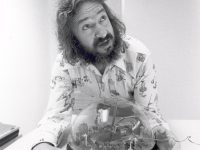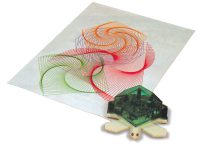On February 4, 1927, German-American physicist Rolf William Landauer was born. Landauer made important contributions in diverse areas of the thermodynamics of information processing, condensed matter physics, and the conductivity of disordered media. He is probably best known for the formulation of the eponymous Landauer Principle concerning the energy used during a computer‘s operation.
“We shall call a device logically irreversible if the output of a device does not uniquely define the inputs. We believe that devices exhibiting logical irreversibility are essential to computing. Logical irreversibility, we believe, in turn implies physical irreversibility, and the latter is accompanied by dissipative effects.”
— Rolf Landauer, 1961 [7]
Early Years and Emigration
Rolf Landauer was born on February 4, 1927, in Stuttgart, Germany. He emigrated to the United States in 1938 to escape Nazi persecution of Jews, graduated in 1943 from Stuyvesant High School, one of New York City’s mathematics and science magnet schools, and obtained his undergraduate degree from Harvard in 1945. Following service in the US Navy as an Electrician’s Mate, he earned his Ph.D. from Harvard in 1950.
How Fast can a Computer Be?
Landauer was a pioneer in the attempt to plumb the limits of computers. In a universe ruled by the laws of quantum mechanics and relativity, how fast and powerful can these machines conceivably be? [1] He first worked for two years at NASA, then known as the National Advisory Committee for Aeronautics, and at the age of 25 began a career in semiconductors at IBM. As part of the two-man team responsible for managing IBM’s Research Division in the mid-1960s, he was involved in a number of programs, including the company’s work on semiconductor lasers. In 1969, he was appointed an IBM Fellow.
Electronic Memories and Semiconductors
Although Landauer was an accomplished theoretical physicist, he was most interested in what physics had to say about technology. Thus, his early work at IBM focused on ferroelectric materials, which were regarded as candidates for electronic memories at that time, and on semiconductors.[3] Until Landauer’s landmark work in the early 1960’s, it was widely believed that processing a single bit of information, each 1 or 0 of binary code, inevitably consumed some energy, placing a fundamental constraint on computer power. Landauer showed, to many people’s surprise, that this was not true. As computer technology becomes ever more efficient, calculations can be done with less energy per computation. [1]
The Landauer Principle
In 1961 he proposed the eponymous Landauer’s principle, and rigorously justified and stated important limits to an earlier conjecture by John von Neumann. [4] Landauer’s principle can be understood to be a simple logical consequence of the second law of thermodynamics, which states that the entropy of an isolated system cannot decrease, together with the definition of thermodynamic temperature. For, if the number of possible logical states of a computation were to decrease as the computation proceeded forward (logical irreversibility), this would constitute a forbidden decrease of entropy, unless the number of possible physical states corresponding to each logical state were to simultaneously increase by at least a compensating amount, so that the total number of possible physical states was no smaller than originally (total entropy has not decreased).
The Landauer Limit
Yet, an increase in the number of physical states corresponding to each logical state means that, for an observer who is keeping track of the logical state of the system but not the physical state, the number of possible physical states has increased; in other words, entropy has increased from the point of view of this observer. The maximum entropy of a bounded physical system is finite. To avoid reaching this maximum over the course of an extended computation, entropy must eventually be expelled to an outside environment. Landauer’s principle asserts that there is a minimum possible amount of energy required to erase one bit of information, known as the Landauer limit.
Later Years
Much of Landauer`s research after 1969 related to the kinetics of small structures. He showed that in systems with two or more competing states of local stability, their likelihood depends on noise all along the path connecting them. In electron transport theory, he is particularly associated with the idea, taken from circuit theory, that electric flow can be considered a consequence of current sources as well as applied fields. He was also a pioneer in the area of information handling. His principles have been applied to computers and to the measurement process and are the basis for Landauer’s own demonstration that communication, in principle, can not avoid a small use of energy.
Landauer received many honors in addition to his election to the two national academies and the 1995 Oliver E. Buckley Condensed Matter Physics Prize. He was awarded the 1992 Stuart Ballantine Medal of the Franklin Institute, the 1993 Centennial Medal of Harvard University, and the 1998 Edison Medal of the IEEE. He received an honorary degree from the Technion in Israel and was elected to membership in the European Academy of Arts and Sciences.
Rolf William Landauer died from brain cancer on 28 April 1999, aged 72.
David Wolpert, The Landauer limit and thermodynamics of biological systems, [8]
References and Further Reading:
- [1] George Johnson, Rolf Landauer, Pioneer in Computer Theory, Dies at 72, The New York Times, April 30, 1999.
- [2] Reversible computation, in Strange Paths – Physics, computation, Philosophy
- [3] Robert W. Keyes: Rolf Landauer, in Memorial Tributes: National Academy of Engineering, Volume 9 (2001), p. 183-187.
- [4] John von Neumann – Game Theory and the Digital Computer, SciHi Blog, December 28, 2014.
- [5] Rolf Landauer at Wikidata
- [6] Timeline for Rolf Landauer, via Wikidata
- [7] Rolf Landauer, “Logical reversibility of computation“, IBM Journal Of Research And Development, Vol. 5, no. 3, 1961
- [8] David Wolpert, The Landauer limit and thermodynamics of biological systems, at the Information and Entropy Investigative Workshop, held at NIMBioS 8-10 April 2015, NIMBioS @ youtube
- [9] Computing study refutes famous claim that ‘information is physical’, University of Perugia





